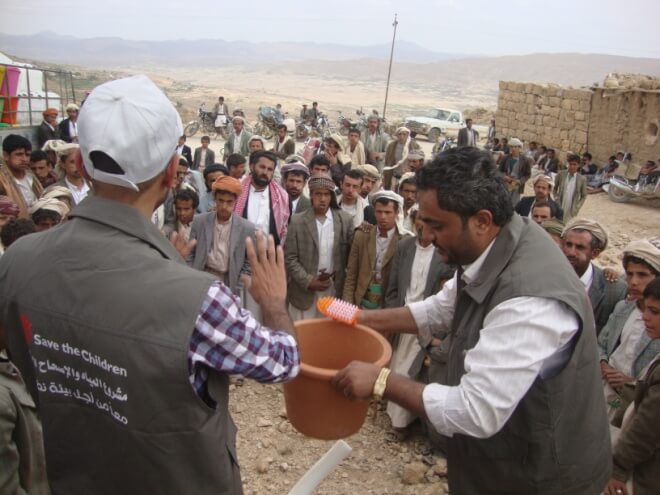Responding to the needs of communities affected by armed conflict in Amran governorate, Yemen
Following clashes between Al Houthi militia and government forces in May and June, Amran governorate experienced a strong movement of Internally Displaced People (IDPs). An estimated 500,000 people were affected, including 6,300 households (44,000 people) displaced. Many left their essential goods behind and lacked access to essential services such as clean water and food. Following the Start Fund alert, Save the Children International (SCI) secured £73,000 for rapid response.
On 8 July 2014, after more than a month of heavy fighting, Al Houthi militia successfully seized full control of Amran City. SCI staff initially conducted a needs assessment in two districts in Sana’a (Bami Al Hareth and Maeen), where the majority of IDPs were displaced, revealing needs for food, shelter, WASH facilities and landmine education. In response, the project planned to distribute hygiene kits along with hygiene awareness messages, ‘privacy sheets’ for lactating mothers along with nutrition counselling and provide training on Mine Risk Education (MRE) for children.
Soon after the cessation of violence, the context changed rapidly. As IDPs returned home, their numbers and locations moved. Following a security assessment in Amran governorate on 17 and 18 July, the project changed its location of implementation to two districts of Amran governorate in order to address the developing needs of returnees in Jebel Eyal Yazeed and Eyal Sorayh instead.
Coordination with multiple power-brokers
Project staff coordinated with many actors involved in the emergency response in Amran. This included the Amran Task Force (UN OCHA group formed specifically for the response in Amran), the relevant clusters (particularly the WASH and Child Protection clusters), Yemen Executive Mine Action Centre (YEMAC), UN OCHA and the Red Crescent Association.
Coordination at the government level presented unique challenges because of the two groups holding power and authority in Amran – the Houthis who actually controlled the region and the governmental authorities. Spending a significant amount of time brokering relationships drew energy away from implementation activities but was necessary to explain the humanitarian principles of the organisation and project. The effort paid off, allowing staff to conduct the programme as originally planned.
Targeting the worst affected
The project focused its efforts on the areas most affected by the conflict – Jebel Eyal Yazeed and Eyal Sorayh Districts. To ensure equitable distribution of aid, the community was involved in the selection process of beneficiaries. The project staff gave briefings on beneficiary selection criteria, and a committee was formed in each area to provide a beneficiary list. SCI verified the lists by sampling that involved going to a selection of villages and speaking with the community leader to confirm that the lists represented the most affected people. The committees also facilitated arrangements for distribution and communication. Partnering with the disaster affected communities increased the speed of implementation, making up for time lost due to the heavy coordination at the government level.
Saving lives through Mine Risk Education
When returning to unsafe areas, IDPs said that children were playing with “strange things” left from the war. One community reported more than three children killed or injured from these mines. In coordination with YEMAC (Yemen Executive Mine Action Centre) and UNICEF, the project ran Mine Risk Education sessions for 1,670 children. Children learned how to avoid explosive materials and were introduced to danger signs. In a post-project focus group discussion, children said they learned “if I was walking and saw something strange, I should not touch it”. The children shared that the training was especially important for those who have to go to the mountains to collect firewood and pasture the goats. They also reported educating their brothers, sisters and friends with the message by visiting neighbours’ houses.
Besides delivering the sessions, the project coordinated with UNICEF and DRC, whose mandate covers landmine victims, to ensure that child victims identified during the project received medical and psychosocial assistance. Project staff are tracking these cases to ensure they are followed though.
Saving lives through providing access to clean water
Having clean water was one of the main challenges for the households targeted because they lacked access to water and sanitation facilities and other hygiene items – putting them at risk of waterborne diseases. The project distributed 1,450 hygiene kits (including water filters and other hygiene items) and conducted hygiene awareness sessions to deliver these services.
In summary, strong coordination at different levels, from government to external partners, as well as strong engagement with the community ensured that Save the Children’s Start Fund project reached households that were most affected and in need of assistance.

